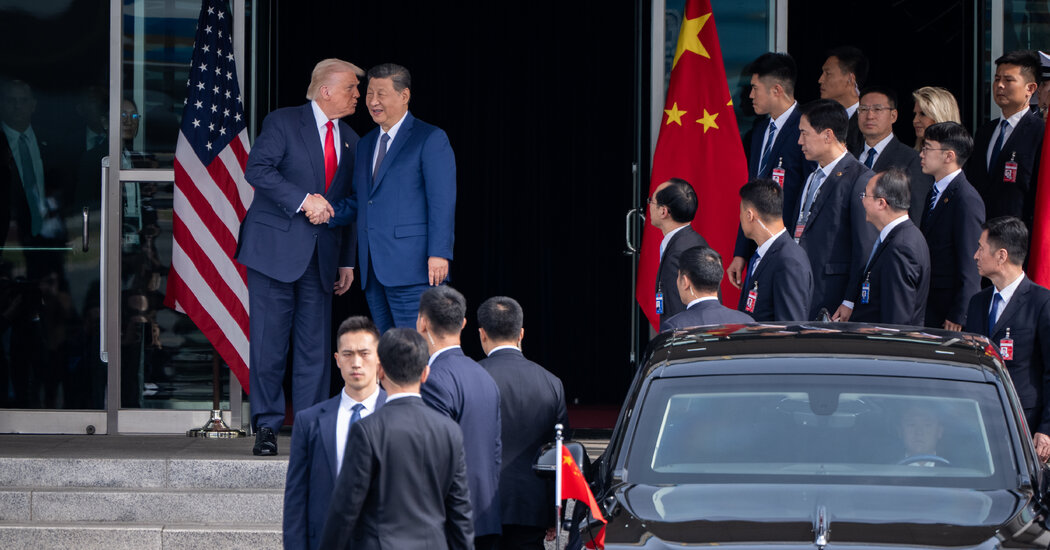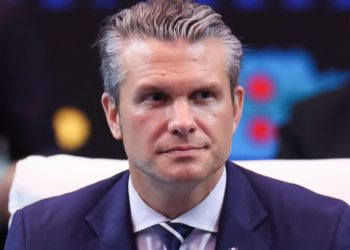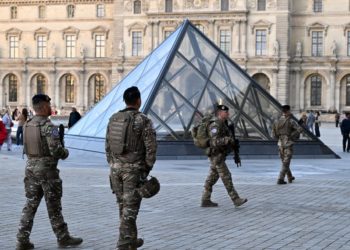After a series of failed attempts to de-escalate an acrimonious trade war, President Trump and China’s leader, Xi Jinping, agreed to a yearlong truce that rolls back many of the contentious tariffs and retaliatory measures that deepened the feud between the world’s two biggest economies.
The two leaders gathered at an airport in Busan, on South Korea’s southeastern coast, for their first in-person meeting of Mr. Trump’s second term with a lot at stake: An economic feud that had simmered for several months was threatening to boil over. Earlier this month, Mr. Trump threatened to levy an additional 100 percent tariff on Chinese goods after China imposed its most stringent restrictions ever on important rare earth metals.
But cooler heads prevailed. The two leaders, after meeting for about 90 minutes, settled on a series of agreements that broke little new ground but unwound thorny issues that had been plaguing negotiations for a lasting trade deal.
Mr. Trump and Mr. Xi agreed to a one-year truce, extending a pause they had put in place after tit-for-tat escalations drove up tariffs on each other’s imports to more than 100 percent. They had initially decided to limit additional tariffs in May, and that was extended by three months in August. The current agreement was set to expire on Nov. 10.
In addition, Mr. Trump told reporters aboard Air Force One, returning to Washington shortly after meeting with Mr. Xi, that he had agreed to halve a punitive 20 percent import duty he had placed on China this year. He had imposed the tariffs after accusing China of failing to prevent fentanyl and the chemicals used in making the powerful synthetic opioid from entering the United States.
He said on Thursday that he agreed to lower the import duty because he believed China was serious about taking the necessary steps to stop the flow of so-called chemical precursors. The reduced tariff would be effective immediately and bring down the overall tariff on many Chinese goods to around 45 percent from about 55 percent.
In addition, Mr. Trump said that China had agreed to suspend for a year a series of new measures that threatened to further curb the supply of rare earth metals, which are crucial for a wide range of advanced manufacturing industries.
Mr. Trump said his summit with the Chinese leader was a “great meeting” and that “a lot of finalization” had been accomplished. He said he expected a trade deal with China “pretty soon.”
“We have not too many stumbling blocks,” said Mr. Trump. “All of the rare earth has been settled.”
The Chinese government, in its official summary of the meeting, was more measured. It said the countries had reached consensus on resolving important economic and trade issues and that officials should finalize “follow-up work” as soon as possible.
In a concession, Mr. Trump said he would postpone plans to impose steep fees on Chinese-built or Chinese-owned ships arriving at U.S. ports. China in turn said it would stand down on its own high fees imposed in retaliation on ships built in the United States, although few of these ships remain on international routes.
Julian Evans-Pritchard, head of China economics for the research firm Capital Economics, said the reduced tariff “takes the immediate threat of large tariff hikes off the table” even though it will not have a major impact on China.
“The underlying forces driving the U.S. and China apart remain unresolved, however, and so tensions could easily flare up again,” he wrote in a note to clients.
The latest trade scuffle between the United States and China began on Sept. 29, when the Commerce Department in Washington expanded its regulations on overseas companies that are barred from doing business with American companies and individuals. The department said the same restrictions would apply to subsidiaries in which a banned company has a stake of 50 percent or more, expanding more than tenfold the number of banned companies, including many Chinese firms.
China retaliated in October with orders requiring export licenses for any overseas sale of a long list of products for which China is the sole or dominant supplier. These rules covered processing equipment and technology for rare earth mines, rare earth refineries and rare earth magnet factories.
The most drastic rule, scheduled to take effect in December, would have given China the authority to regulate any magnet — and possibly any product at all — manufactured outside China that had at least 0.1 percent of its value coming from Chinese rare earth metals.
China agreed on Thursday to suspend the implementation of these latest measures for one year.
U.S. and Chinese officials seemed to be turning down the temperature ahead of the Trump-Xi meeting. Last weekend, negotiators from the two countries announced they had reached a “framework” of a deal for the two leaders to discuss.
At the start of the meeting, Mr. Xi said the two countries “do not always see eye to eye” and that “it is normal for the two leading economies of the world to have frictions now and then.” He said he believed that “China’s development goes hand in hand with your vision to make America great again.”
Mr. Trump was strikingly conciliatory with Mr. Xi, calling him a “very tough negotiator” as the two men shook hands for photographs before they began negotiations. He paused before adding “and that’s not good.”
The meeting took place at the end of Mr. Trump’s nearly weeklong trip to Asia that resulted in announced trade deals with South Korea, Malaysia and Cambodia.
After the meeting, Mr. Xi headed to the Asia-Pacific Economic Cooperation summit in the historic South Korean city of Gyeongju, where he was expected to meet with the leaders of South Korea and Japan.
Mr. Trump and Mr. Xi agreed to meet again next year. Mr. Trump said he was planning to visit China in April, followed by a visit from Mr. Xi to the United States in Florida or Washington.
At the meeting, Mr. Trump said China agreed to resume buying American soybeans in “large quantities.” China this year had made a sudden stoppage of its purchases, a devastating blow for many American farmers, because China bought more than half of all American soybean exports last year.
Mr. Trump said the two leaders discussed semiconductors. He did not rule out the possibility of allowing Nvidia, the American chip giant, to sell its artificial intelligence chips to China. He said the matter needed to be discussed by Chinese officials and the company — with the United States playing “referee.”
The two sides did not discuss Blackwell, Nvidia’s most advanced semiconductor, according to Mr. Trump. He fueled speculation earlier this week that he may lift restrictions preventing China from gaining to the chip.
The Chinese government did not mention any agreement regarding semiconductors.
There was no meaningful update for the fate of TikTok. The White House has claimed for more than a month that it has been in the final stages of making a deal to separate TikTok from its Chinese owner, ByteDance, so that the company can keep operating in the United States.
China’s Ministry of Commerce mentioned the social media platform in passing, stating that two countries planned “to properly resolve issues” related to TikTok without elaborating further. Mr. Trump did not mention the company in his remarks.
Daisuke Wakabayashi is an Asia business correspondent for The Times based in Seoul, covering economic, corporate and geopolitical stories from the region.
Keith Bradsher is the Beijing bureau chief for The Times. He previously served as bureau chief in Shanghai, Hong Kong and Detroit and as a Washington correspondent. He lived and reported in mainland China through the pandemic.
The post Trump and Xi, Hoping to Ease Trade War, Agree to 1-Year Truce appeared first on New York Times.




